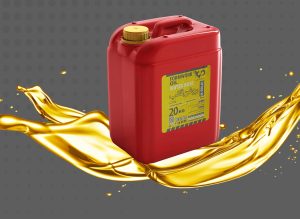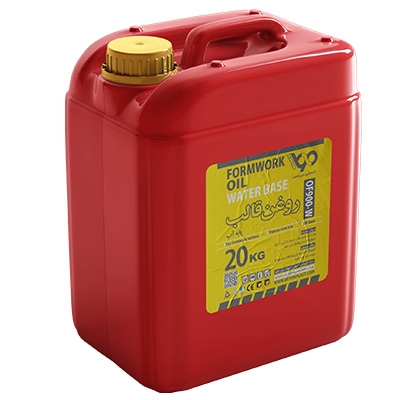Mould oil (water base)
Description
Description: Mould oil (water base)
Mould oil is based on water and is a type of emulsion oil that creates a very thin film on the surfaces of metal or concrete or wooden molds, making it easier to separate the mold from the concrete.

Features:
- Enables better passage and movement of air bubbles in the vicinity of molds
- No negative effect on color adhesion or sealing and restorative mortars on concrete surface
- Non-toxic and non-flammable
Applications:
- Suitable for metal mold surfaces
- Suitable for use on surfaces of rubber molds, for the production of artificial stone
- Suitable for producing concrete with exposis surface
Technical specification table:
| Appearance | liquid |
| Color | brown |
| Specific gravity | gr/cm3 0/85 |
| standard | CE 204 – CE 1407 |
| Ion chlorine | Doesn’t have |
Package:
20 kg gallon
Product Description – Water-based Molding Oil
For optimal concreting, standard principles must be followed from the stage of selecting and mixing concrete mixing materials to the stage of curing and maintaining concrete. One of the important stages in this process is concrete molding, which is done with the help of metal, wooden, or plastic molds. The mold surface must be of such a quality that the concrete can be easily released from the mold surface and the lack of quality of the mold surface does not affect the concrete surface, whether it is chipping or porosity. For this reason, it is necessary to lubricate the surface of the concrete molds with a special substance before concreting so that both the concrete can be easily separated from the mold and the quality of the concrete surface is desirable. For this reason, the mold oil product has been formulated and produced. Mold oil is water-based and is a type of emulsion oil that, by creating a very thin film on the surfaces of metal, concrete, or wooden molds, makes it easier to separate the mold from the concrete. Another advantage of using water-soluble mold oil is the absence of surface bubbles. In traditional methods, burnt oil was used to lubricate the surface of the molds, which is now obsolete. The advantages of using water-based mold oil over burnt oil include the ease of movement of air bubbles in the vicinity of the mold, which quickly disappear after opening the mold, preventing discoloration of the concrete surface, and preventing adhesion of paint or repair and sealing materials to the concrete surface.
Generally, this product is also called a release agent or form release oil, which is water-based, and is used in the construction industry. Specifically, water-based form oil is a non-damaging concrete release agent formulated and manufactured for use on wooden or metal forms.
Water-based molding oil packaging
20 liter gallon
220 liter barrel
1000 liter tank
Water-based mold oil consumption
The amount of mold oil consumed varies depending on the type of mold and the degree of porosity and roughness of the mold surface.
Normally, if you add half to 1 liter of water to each liter of molding oil, you can cover 10 to 12 square meters of surface.
Learn more; Mold oil (solvent based)
Water-based mold oil maintenance
Duration: Six months in original packaging.
Conditions: Away from cold and frost, heat and direct and prolonged sunlight.
Best storage temperature: +10 to +30 degrees
How to use water-based mold oil
- It is recommended that the container containing the product be turned over several times before using the mold oil, or if possible, stirred with a mechanical stirrer.
- Each unit of mold oil can be mixed with 50 to 100 percent water and then used.
- It is best to have the surface of the molds free of dust or concrete and cement before applying mold oil.
- If there are concrete or mortar stains on the surface of the mold, remove the contamination by applying water pressure (water jet) or using sandblasting.
- If there are many cement stains on the surface of the mold, remove the cement stain using a cement cleaning product from metal tools.
- Apply the mold oil to the surface using a roller, brush, or spray.
- Note that water-based mold oil can also be used in its pure form.
Properties and effects of water-based molding oil
- No need to apply impact to separate the mold from the concrete
- Better passage and movement of air bubbles in the vicinity of the molds
- Ease of cleaning tools and molds using water
- Preventing discoloration on the concrete surface
- Economical compared to similar methods
- Proper and optimal coverage on the surface of the molds
- Increasing the life and durability of concrete forms
- No need to clean and scrape concrete from the surface of the molds.
- No contamination of the concrete surface, no negative effects
- No negative impact on the adhesion of paint or sealing and repair mortars on the concrete surface
- Non-toxic and non-flammable
- Produces concrete with a smoother surface than formwork, without the use of formwork oil
Applications Water-based mold oil
- Suitable for application on metal mold surfaces
- Can be used on all types of wooden and plastic molds
- Suitable for use on rubber mold surfaces for the production of artificial stone.
- Suitable for greasing the molds of concrete sections, which are to be sealed or insulated and repaired after opening the molds.
- Suitable for producing concrete with exposed surface
Table of physical and chemical properties of water-based molding oil
| Title | Feature |
| Mode | Liquid |
| Color | Brown-milky |
| Specific gravity | 0.85g/cm3 |
| Chlorine ion | No |
| Standard | CE 204 – CE 1407 |
| Dissolvability | In the water |
| PH | About 7 |
Mechanism of action of water-based molding oil
Water-based mold oil creates special advantages by forming a greasy layer on the surface of the molds before concreting. One of the most important features of using mold oil is that the concrete is easier to release from the mold surface, which is why mold oil is also called a mold release agent. In addition to helping the concrete to be easily separated from the mold, mold oil creates a smooth and non-porous surface by forming a greasy layer between the mold surface and the concrete. One of the most important features that mold oil creates is that when the molds are opened, the concrete does not stick to the mold, and thus there will be no scratching on the concrete surface and the need to re-repair the surface, as well as cleaning and removing concrete from the mold surface.
Water-based mold oil safety
- This material is non-toxic and safe for the environment.
- Wear a mask, gloves, and safety glasses when working.
- Do not swallow or come into contact with eyes.
- In case of contact with skin or eyes, wash with plenty of lukewarm water.
Water-based mold oil standard
CE 1407 – CE 204 standard






Reviews
There are no reviews yet.